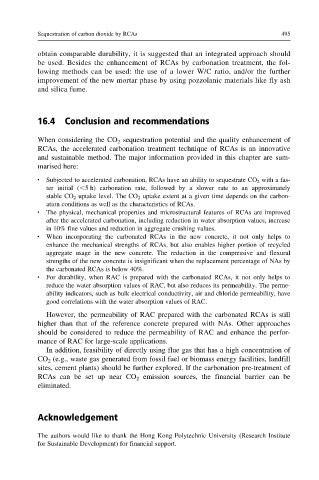Page 547 - New Trends in Eco efficient and Recycled Concrete
P. 547
Sequestration of carbon dioxide by RCAs 495
obtain comparable durability, it is suggested that an integrated approach should
be used. Besides the enhancement of RCAs by carbonation treatment, the fol-
lowing methods can be used: the use of a lower W/C ratio, and/or the further
improvement of the new mortar phase by using pozzolanic materials like fly ash
and silica fume.
16.4 Conclusion and recommendations
When considering the CO 2 sequestration potential and the quality enhancement of
RCAs, the accelerated carbonation treatment technique of RCAs is an innovative
and sustainable method. The major information provided in this chapter are sum-
marised here:
Subjected to accelerated carbonation, RCAs have an ability to sequestrate CO 2 with a fas-
ter initial (,5 h) carbonation rate, followed by a slower rate to an approximately
stable CO 2 uptake level. The CO 2 uptake extent at a given time depends on the carbon-
ation conditions as well as the characteristics of RCAs.
The physical, mechanical properties and microstructural features of RCAs are improved
after the accelerated carbonation, including reduction in water absorption values, increase
in 10% fine values and reduction in aggregate crushing values.
When incorporating the carbonated RCAs in the new concrete, it not only helps to
enhance the mechanical strengths of RCAs, but also enables higher portion of recycled
aggregate usage in the new concrete. The reduction in the compressive and flexural
strengths of the new concrete is insignificant when the replacement percentage of NAs by
the carbonated RCAs is below 40%.
For durability, when RAC is prepared with the carbonated RCAs, it not only helps to
reduce the water absorption values of RAC, but also reduces its permeability. The perme-
ability indicators, such as bulk electrical conductivity, air and chloride permeability, have
good correlations with the water absorption values of RAC.
However, the permeability of RAC prepared with the carbonated RCAs is still
higher than that of the reference concrete prepared with NAs. Other approaches
should be considered to reduce the permeability of RAC and enhance the perfor-
mance of RAC for large-scale applications.
In addition, feasibility of directly using flue gas that has a high concentration of
CO 2 (e.g., waste gas generated from fossil fuel or biomass energy facilities, landfill
sites, cement plants) should be further explored. If the carbonation pre-treatment of
RCAs can be set up near CO 2 emission sources, the financial barrier can be
eliminated.
Acknowledgement
The authors would like to thank the Hong Kong Polytechnic University (Research Institute
for Sustainable Development) for financial support.

